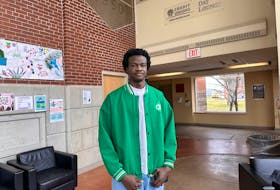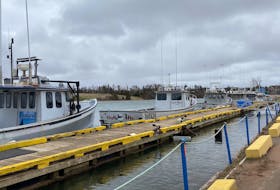At least until he finds something else on it to tweak.
“All systems a go,” laughed Cameron, during a recent tour he gave the Journal Pioneer.
Cameron’s Earthship has garnered a lot of attention over the past year or so. Everywhere he goes, he said, people want to know about it and how its construction is going.
“I know the speal like the back of my hand now, I live it, it’s ingrained in my bones. So yeah, a lot of people curious, with reason,” he said.
The only major bit left to complete is the tiling of the bathroom, he said, and he’s eventually going to install solar panels on the roof to generate electricity.
But besides those two things, the Earthship is now livable.
To celebrate that fact, Cameron will be hosting an open house on Aug. 8. Everyone who wants to take a look or ask him some questions is welcome to stop by. The structure can be found just past Day’s Corner, at the intersection of Route 2 and Maple Leaf Lane.
It will be a nice chance to show his appreciation for all the support everyone has given him throughout this year-long project, he said.
“This happened solely with the help of many great friends.”
The term ‘Earthship’ is used to describe homes built using a method developed by Earthship Biotecture of Taos, New Mexico, in the early 1970s.
They use recycled junk as a primary building material (tires for walls among other innovations) and have a very small environmental footprint as a result.
They also use passive solar as a primary source of heat (hence the big windows) with a small wood stove as backup. They also use solar power for electricity and catch and store rainwater for their primary water source. Washing water is filtered into an indoor greenhouse.
Cameron is a graduate of the construction technology program at Holland College and completed a course in the U.S. on constructing Earthships. He helped build two of them in the U.S. before attempting his own on a some family land in Wellington Centre.
He started out with a volunteer crew from all over North America and quickly had the shell of the home up in about two months. He’s been picking away at the rest of the work ever since.
The construction cost him about $60,000, plus $5,000 he raised from supporters on the on crowdfunding website Kickstarter.com.
But Cameron isn’t resting on his laurels. He’s already looking for some land to build a second Earthship and spends a lot of time thinking about how to perfect the method. He plans on living in the one he already has for the foreseeable future and has some ideas as to what to do with it in the long-term, but he’s not quite ready to share those yet.
People will just have to stay interested and find out, he said.
“It was a great experience, a lot learned and I’ll be sure to use that knowledge when I build another one,” he said.
@JournalPMacLean
At least until he finds something else on it to tweak.
“All systems a go,” laughed Cameron, during a recent tour he gave the Journal Pioneer.
Cameron’s Earthship has garnered a lot of attention over the past year or so. Everywhere he goes, he said, people want to know about it and how its construction is going.
“I know the speal like the back of my hand now, I live it, it’s ingrained in my bones. So yeah, a lot of people curious, with reason,” he said.
The only major bit left to complete is the tiling of the bathroom, he said, and he’s eventually going to install solar panels on the roof to generate electricity.
But besides those two things, the Earthship is now livable.
To celebrate that fact, Cameron will be hosting an open house on Aug. 8. Everyone who wants to take a look or ask him some questions is welcome to stop by. The structure can be found just past Day’s Corner, at the intersection of Route 2 and Maple Leaf Lane.
It will be a nice chance to show his appreciation for all the support everyone has given him throughout this year-long project, he said.
“This happened solely with the help of many great friends.”
The term ‘Earthship’ is used to describe homes built using a method developed by Earthship Biotecture of Taos, New Mexico, in the early 1970s.
They use recycled junk as a primary building material (tires for walls among other innovations) and have a very small environmental footprint as a result.
They also use passive solar as a primary source of heat (hence the big windows) with a small wood stove as backup. They also use solar power for electricity and catch and store rainwater for their primary water source. Washing water is filtered into an indoor greenhouse.
Cameron is a graduate of the construction technology program at Holland College and completed a course in the U.S. on constructing Earthships. He helped build two of them in the U.S. before attempting his own on a some family land in Wellington Centre.
He started out with a volunteer crew from all over North America and quickly had the shell of the home up in about two months. He’s been picking away at the rest of the work ever since.
The construction cost him about $60,000, plus $5,000 he raised from supporters on the on crowdfunding website Kickstarter.com.
But Cameron isn’t resting on his laurels. He’s already looking for some land to build a second Earthship and spends a lot of time thinking about how to perfect the method. He plans on living in the one he already has for the foreseeable future and has some ideas as to what to do with it in the long-term, but he’s not quite ready to share those yet.
People will just have to stay interested and find out, he said.
“It was a great experience, a lot learned and I’ll be sure to use that knowledge when I build another one,” he said.
@JournalPMacLean








